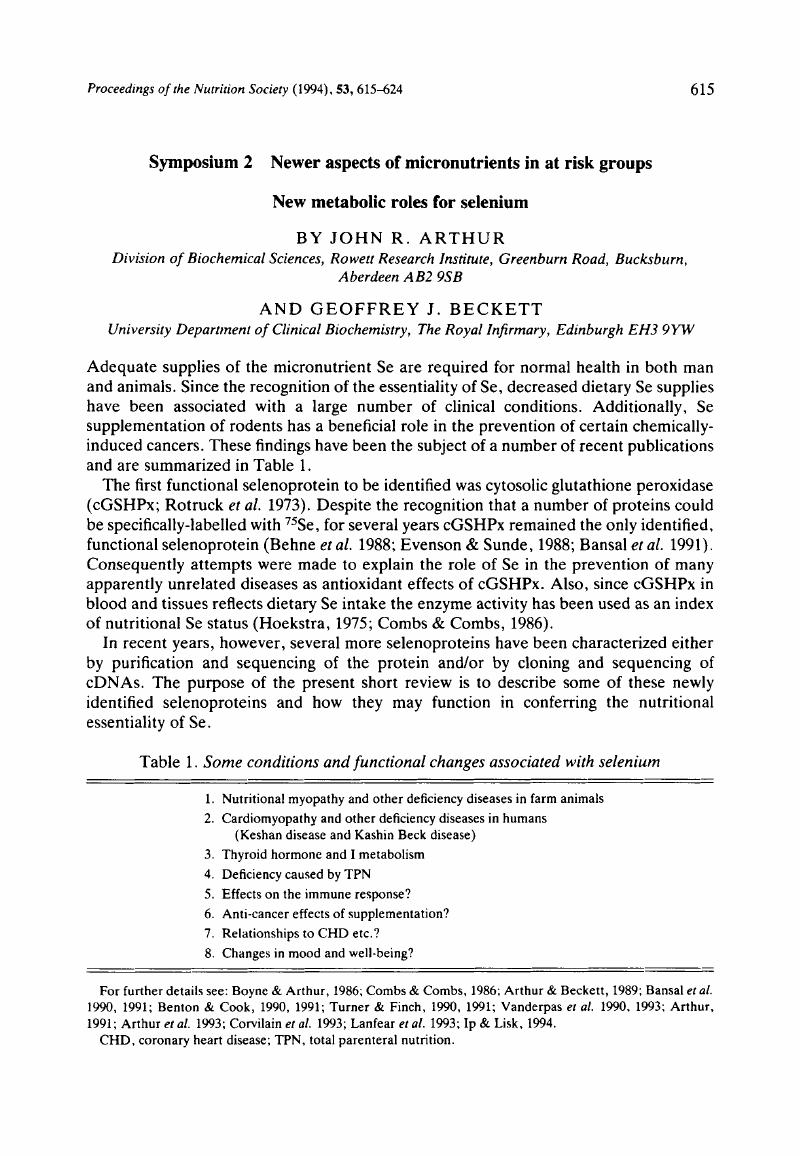Crossref Citations
This article has been cited by the following publications. This list is generated based on data provided by Crossref.
Bermano, Giovanna
Nicol, Fergus
Dyer, John A.
Sunde, Roger A.
Beckett, Geoffrey J.
Arthur, John R.
and
Hesketh, John E.
1996.
Selenoprotein gene expression during selenium-repletion of selenium-deficient rats.
Biological Trace Element Research,
Vol. 51,
Issue. 3,
p.
211.
Rayman, Margaret P.
Abou-Shakra, Fadi R.
Ward, Neil I.
and
Redman, Christopher W. G.
1996.
Comparison of selenium levels in pre-eclamptic and normal pregnancies.
Biological Trace Element Research,
Vol. 55,
Issue. 1-2,
p.
9.
Reilly, Conor
1996.
Selenium in Food and Health.
p.
25.
1996.
Abstracts Of Communications.
Proceedings of the Nutrition Society,
Vol. 55,
Issue. 1A,
p.
1A.
Zloch, Z.
1996.
Therapeutic Uses of Trace Elements.
p.
225.
1996.
Clinical development plan: \-Selenomethionine.
Journal of Cellular Biochemistry,
Vol. 63,
Issue. S26,
p.
202.
Sattar, Naveed
Eatock, Fiona
Fell, Gordon S
and
O'Reilly, Denis
1997.
Selenium: An Acute-Phase Reactant?.
Annals of Clinical Biochemistry: International Journal of Laboratory Medicine,
Vol. 34,
Issue. 4,
p.
437.
Thurnham, David I.
1997.
Impact of disease on markers of micronutrient status.
Proceedings of the Nutrition Society,
Vol. 56,
Issue. 1B,
p.
421.
Nichol, Colin
Herdman, Jacqueline
Sattar, Naveed
O’Dwyer, Patrick J
O’Reilly, Denis St J
Littlejohn, David
and
Fell, Gordon
1998.
Changes in the Concentrations of Plasma Selenium and Selenoproteins after Minor Elective Surgery: Further Evidence for a Negative Acute Phase Response?.
Clinical Chemistry,
Vol. 44,
Issue. 8,
p.
1764.
Arthur, J. R.
1998.
Oxidative Stress in Skeletal Muscle.
p.
317.
Leung, Fred Y.
1998.
Trace elements that act as antioxidants in parenteral micronutrition 11This paper was delivered at the January 18, 1998, workshop “Frontiers in Antioxidant Research: 14th Annual A.S.P.E.N. Workshop,” which was held the day before the official start of the 22nd A.S.P.E.N. Clinical Congress in Orlando, FL..
The Journal of Nutritional Biochemistry,
Vol. 9,
Issue. 6,
p.
304.
Yan, Jun
and
Barrett, John N.
1998.
Purification from Bovine Serum of a Survival-Promoting Factor for Cultured Central Neurons and Its Identification as Selenoprotein-P.
The Journal of Neuroscience,
Vol. 18,
Issue. 21,
p.
8682.
Reilly, Conor
1998.
Selenium: A new entrant into the functional food arena.
Trends in Food Science & Technology,
Vol. 9,
Issue. 3,
p.
114.
Hawkins, R. A.
Sangster, Kathryn
and
Arends, M. J.
1998.
Apoptotic death of pancreatic cancer cells induced by polyunsaturated fatty acids varies with double bond number and involves an oxidative mechanism.
The Journal of Pathology,
Vol. 185,
Issue. 1,
p.
61.
NAM, Sang-Yoon
MAEDA, Seishi
FUJISAWA, Masahiko
KUROHMARU, Masamichi
and
HAYASHI, Yoshihiro
1998.
Expression Pattern of Mitochondrial Capsule Selenoprotein mRNA in the Hamster Testis..
Journal of Veterinary Medical Science,
Vol. 60,
Issue. 11,
p.
1175.
NAM, Sang-Yoon
MAEDA, Seishi
FUJISAWA, Masahiko
KUROHMARU, Masamichi
and
HAYASHI, Yoshihiro
1998.
Cloning and Expression of Mitochondrial Capsule Selenoprotein Gene in the Golden Hamster..
Journal of Veterinary Medical Science,
Vol. 60,
Issue. 10,
p.
1113.
Kelloff, Gary J.
1999.
Vol. 78,
Issue. ,
p.
199.
Patching, S.G.
and
Gardiner, R.H.E.
1999.
Recent Developments in Selenium Metabolism and Chemical Speciation: A Review.
Journal of Trace Elements in Medicine and Biology,
Vol. 13,
Issue. 4,
p.
193.
Dissanayake, C.B
and
Chandrajith, Rohana
1999.
Medical geochemistry of tropical environments.
Earth-Science Reviews,
Vol. 47,
Issue. 3-4,
p.
219.
Sheehan, T M T
and
Halls, D J
1999.
Measurement of Selenium in Clinical Specimens.
Annals of Clinical Biochemistry: International Journal of Laboratory Medicine,
Vol. 36,
Issue. 3,
p.
301.



